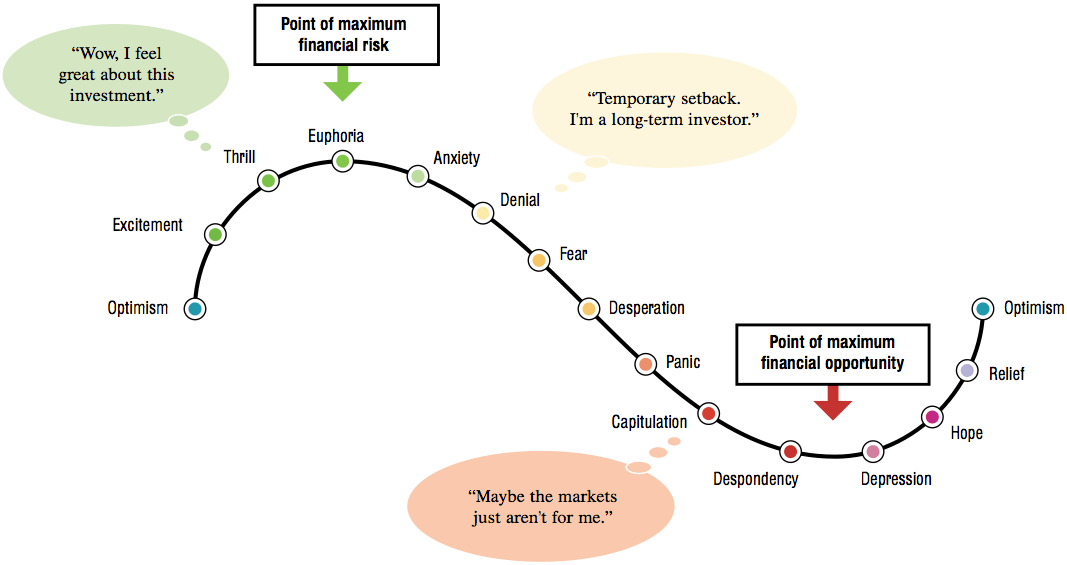Download the AMM Q1 2018 Client Letter
There is a saying attributed to Mark Twain that goes “History doesn’t repeat itself, but it often rhymes.” Just as there is a business and economic cycle represented by expansion and contraction, there is a market cycle characterized by bullish rising prices and bearish falling prices. The specific events and catalysts driving these cycles are sure to change from one period to the next, but the cycles themselves are a hallmark of our economic system, repeating throughout history. Unfortunately, those “specific events and catalysts” are so different from one cycle to the next that the ability to correctly and accurately forecast these cycles is akin to having a crystal ball.
The good news is that we do not need a crystal ball or any other forecasting device to make sound investment decisions. We can progress through rational and unemotional assessments about current valuations and economic conditions, and then position portfolios accordingly. Instead of trying to predict the future, we rely heavily on what we know today in making investment decisions. This methodology is guided by our firm’s five core principles: 1) asset allocation is the most important decision; 2) volatility is not risk – real risk is the likelihood of permanent capital impairment; 3) the price you pay determines your return; 4) time is your ally, but investment returns are not linear; and 5) we cannot predict the future.
The bad news is that making rational and unemotional investment decisions is more challenging than it looks on the surface. This is because there is a deeper behavioral cycle that accompanies the economic and market cycles. This cycle resides just under the surface of our psyches and can be a key driver of an investor’s decision making, often without their conscious consent. We will refer to this as the Investor Emotion Cycle (Exhibit A):
Exhibit A:
Some of the most famous investor quotes in history relate specifically to this cycle. From Baron Rothschild’s 18th century maxim “buy when there is blood in the streets” (i.e. point of maximum financial opportunity) to Warren Buffett’s “you want to be greedy when others are fearful (panic), and fearful when others are greedy (euphoria)”, great investors recognize the importance that behavior and emotions play in investing. Anyone who has invested through a full market cycle probably recognizes some of the emotions in Exhibit A. The great challenge facing all investors is both recognizing and taming these emotions. Easier said than done.
When your investments have declined in value by any meaningful amount, the desperation-depression phase kicks in. It is pretty difficult to be a buyer here because 1) you are too fearful, 2) you don’t have any money to buy with, and/or 3) your confidence is severely shaken since you may feel “stupid” for having “lost” the money in the first place or for having placed it in the care of an advisor who failed to avoid a market downturn. The fear factor might cause you to capitulate and sell the stocks that have declined and re-position to cash and conservative bonds. Conversely, when your stock investments have been increasing at a consistent clip, you may want to re-position any conservative holdings in bonds or cash in favor of the “better returns” from stocks. In the aggregate, these emotional decisions are akin to buying high and selling low.
Managing the Investor Emotion Cycle
While there is not an easy remedy to the Investor Emotion Cycle, the first step is recognizing it exists and remembering it each time you make an investment decision. There are some important additional steps you can take to help counteract the investor emotion cycle:
Focus on Return Relative To Risk: Many investors seek to “maximize return” without regard to risk. This attitude is especially present during bull markets. However, only focusing on return sows the seeds of the investors’ demise when markets turn down, as they are overexposed to risk-oriented assets. To combat this, investors should develop an appropriate asset allocation target for their unique risk tolerance and objectives, independent of the current market environment. The asset allocation decision helps to determine how much potential downside exposure an investor is comfortable with compared with the potential upside reward, which could range anywhere from 100% stocks to 100% conservative income securities (and every variation in between).
Systemize Your Trading: Once an appropriate asset allocation has been developed, investors should periodically rebalance their portfolio back to the pre-determined target allocation. This means that a strong period for stock returns will result in selling some stocks and reallocating to assets that have performed less well (bonds, cash, etc.). This systematically causes the investor to buy low and sell high, helping to combat the emotional tendency to do the opposite.
Focus on Quality: The global stock, bond and real estate markets combined represent literally hundreds of thousands of potential investment opportunities. Prudent investors need not subject themselves to low quality investments or long-shots. When investing in individual stocks, we select companies that we define as high quality. These companies will generally have one or more of the following characteristics: 1) strong competitive advantage in their industry; 2) high returns on shareholder equity and total capital; and/or 3) a policy of paying and consistently growing dividend payments to shareholders.
Finally, remember that volatility and portfolio declines are a normal part of investing. If during a market decline or recession your investments go down in value, it does not mean that you and/or your investment manager are doing the wrong thing. On a calendar year basis since 1980, markets have historically gone up around 78% of the time, leaving 22% of the time for downturns. Some of these sell offs are minor blips, while others represent huge drawdowns like 2008. By focusing on the right asset allocation for your unique situation, rebalancing regularly, and sticking to quality, you will survive the inevitable market downturn and maximize your risk adjusted returns when markets eventually recover.
2017 Year in Review and Curren Outlook
Through 12/31/17, domestic stocks (S&P 500) increased 21.8%, developed market international stocks (EAFE) increased 25.0%, and emerging markets (EM) increased 37.3%. Bonds (Bar Cap Agg Idx) were up 3.5%, commodities were up 4.4%, and gold was up 11.9%. We have updated our asset class return chart to reflect calendar year 2017 along with three and ten year annualized returns for the aforementioned asset classes.
2017 was a year when investors ignored the dire headlines including North Korean missile threats, investigations of the Presidency, hurricane devastation, and a rapidly-growing national deficit, to produce one of the smoothest investment rides in the past century. The VIX “fear” index has produced the lowest volatility since data has been collected starting in 1990. In October, the S&P 500 index broke its all-time record of consecutive days without a 3% drawdown. The biggest single-day drop in 2017 was just under 2%.
How long can this continue? Who knows? While we cannot predict with any real precision when the next market downturn will occur or when volatility will return, we can focus on what we do know and act accordingly. We know that US Stocks (S&P 500) are now trading at around 18 times forward earnings, which is above the historical average of 16—which, loosely translated, means you are not getting a bargain when you buy the S&P 500 today. We know that the low volatility experienced by markets over the last few years is the exception and not the rule of investing in publicly traded stocks. We know that the Federal Reserve has been increasing interest rates and that rates will likely rise further in 2018. We also suspect that the Fed may move more aggressively towards reducing their balance sheet by selling billions of dollars of bonds they purchased in the last cycle.
While the above points would suggest a more cautious stance, we cannot ignore the positive developments that have helped to underpin this market. We are experiencing low unemployment rates and solid profits for American companies. 2017 may show the highest growth for S&P 500 earnings since 2011, while the U.S. economy is growing at a 3% rate. The somewhat controversial tax cuts provide a fiscal stimulus at a time when monetary stimulus (Fed Policy) is waning, which could perhaps provide cover to the Fed as they continue to normalize interest rates. Globally, all 45 Organization for Economic Cooperation and Development (OECD) economies are likely to post growth for 2017. Finally, the psychology of the markets does not match what you traditionally see at euphoric market tops. People still seem to be suspicious about how long the market rally will last, unlike the normal buying frenzy that often presages the next sharp downturn. If we had to guess, we are somewhere between optimism and excitement on the Investor Emotion Cycle.
All of this leaves us in a marginally cautious position as we enter 2018. The global economy is strong, but markets are generally expensive. Volatility is low but will likely trend higher over time. Same goes for interest rates. While we do not expect to make significant asset policy or strategy changes in the near term, we will continue to rebalance portfolios according to their strategy objectives. All else being equal, this will likely result in stock reductions given the strength in these asset markets in 2017.
*Individual accounts will vary based on a client’s stated objectives, risk tolerance and time frame. We manage several different portfolio strategies, so not every client has exposure to the securities, asset classes or trading strategies discussed above. In addition to growth and/or income oriented asset allocation strategies, we also manage more concentrated equity portfolios that generally carry a higher degree of risk and volatility. Please contact us if you want to discuss your portfolio strategy in greater detail.
Should you have any questions regarding your investment account(s) and personal financial plans, or if there have been any recent changes to your investment and/or retirement objectives, please do not hesitate to contact our office to speak with one of us at your convenience. We can also provide you with a current copy of our SEC Form ADV Part II, at your request.
As always, we thank you for entrusting AMM to help you achieve your investment and retirement objectives.





